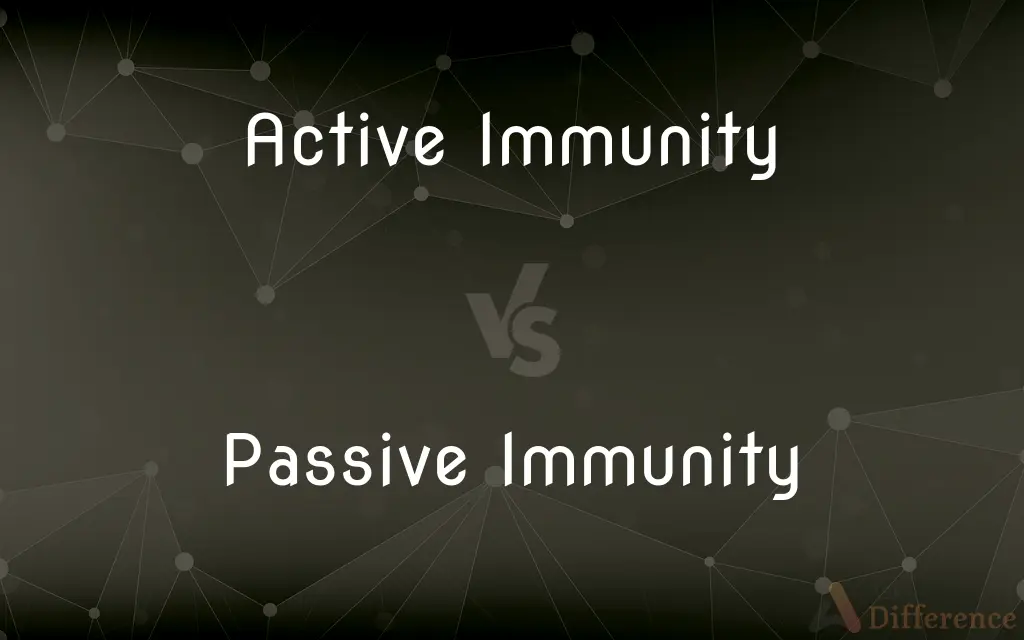Active Immunity vs. Passive Immunity — What's the Difference?
By Tayyaba Rehman — Published on January 12, 2024
Active Immunity results from the body's response to antigens, providing long-term protection, while Passive Immunity involves temporary protection by receiving antibodies, not engaging the immune system directly.

Difference Between Active Immunity and Passive Immunity
Table of Contents
ADVERTISEMENT
Key Differences
Active immunity refers to the immune response generated by the body, triggered by exposure to pathogens or antigens. It involves the production of antibodies and memory cells, conferring long-term protection against specific infections.
Passive immunity, in contrast, occurs when antibodies are transferred to an individual rather than being produced by their immune system. This transfer can happen naturally, such as from a mother to a fetus, or artificially through injections of antibodies, offering immediate but temporary protection.
Active immunity involves the body's immune system actively recognizing and responding to antigens. It's initiated by exposure to pathogens or vaccines, stimulating the production of antibodies tailored to combat specific threats.
Passive immunity doesn't engage the recipient's immune system. Instead, pre-formed antibodies are directly transferred, offering immediate but short-lived protection without stimulating the production of memory cells.
The immunity acquired through active processes provides lasting protection against future exposure to the same pathogen, thanks to the memory cells that remember the antigen.
ADVERTISEMENT
Passive immunity is temporary, providing immediate but brief protection, and doesn't create memory cells, leaving the individual susceptible upon antibody degradation.
Comparison Chart
Source
Generated by the body's immune response
Derived from antibodies received from an external source
Initiation
Triggered by exposure to antigens or vaccines
Through direct transfer of antibodies
Duration
Long-term protection due to memory cell formation
Short-term protection without memory cell involvement
Immune System
Engages the immune system to produce antibodies
No immune response engagement, immediate antibody transfer
Example
Immunization through vaccines
Antibodies passed from a mother to a fetus
Compare with Definitions
Active Immunity
Immune response triggered by exposure.
Vaccination triggers active immunity, creating lasting protection.
Passive Immunity
Immediate but fleeting protection.
Temporary defense in passive immunity lasts as long as transferred antibodies remain.
Active Immunity
Induced by exposure to pathogens.
Active immunity develops after exposure to disease-causing agents.
Passive Immunity
Acquired without immune system activation.
Passive immunity is achieved by receiving ready-made antibodies.
Active Immunity
Long-term protection via memory cells.
After infection, active immunity builds defense for future encounters.
Passive Immunity
Temporary defense via received antibodies.
Infants acquire passive immunity through maternal antibodies.
Active Immunity
Immune system's response to antigens.
Active immunity is the body's defense against recognized threats.
Passive Immunity
No immune response involvement.
Passive immunity doesn't engage the recipient's immune system.
Active Immunity
Body generates antibodies.
Active immunity involves the body producing its antibodies.
Passive Immunity
Short-term protection from external antibodies.
Passive immunity offers immediate but short-lived protection.
Common Curiosities
How is active immunity achieved?
Active immunity develops when the body's immune system responds to exposure to pathogens or vaccines.
Can vaccines induce active immunity?
Yes, vaccines stimulate the immune system to develop active immunity by exposing it to harmless forms of pathogens or their components.
Does active immunity provide long-lasting protection?
Yes, active immunity typically offers prolonged protection due to the formation of memory cells.
What is an example of passive immunity?
Passive immunity occurs when a person receives pre-formed antibodies through treatments like immunoglobulin therapy.
Can active immunity be naturally acquired?
Yes, active immunity naturally develops when a person's immune system encounters and responds to pathogens during infection.
What role do memory cells play in active immunity?
Memory cells are crucial in active immunity, enabling the immune system to recognize and respond rapidly upon subsequent exposure to the same pathogen.
How is passive immunity transferred artificially?
Passive immunity can be transferred artificially by administering pre-formed antibodies, as in certain medical treatments.
Can passive immunity be naturally acquired?
Yes, passive immunity naturally occurs when antibodies are transferred from a mother to her baby during pregnancy or breastfeeding.
How long does passive immunity last?
Passive immunity is temporary and lasts only as long as the transferred antibodies remain in the recipient's system.
Does passive immunity involve the immune system?
No, passive immunity does not engage the recipient's immune system; it directly transfers antibodies for protection.
Share Your Discovery

Previous Comparison
Subnetting vs. Supernetting
Next Comparison
Jews vs. ChristiansAuthor Spotlight
Written by
Tayyaba RehmanTayyaba Rehman is a distinguished writer, currently serving as a primary contributor to askdifference.com. As a researcher in semantics and etymology, Tayyaba's passion for the complexity of languages and their distinctions has found a perfect home on the platform. Tayyaba delves into the intricacies of language, distinguishing between commonly confused words and phrases, thereby providing clarity for readers worldwide.
















































